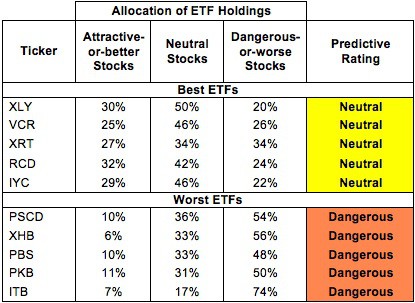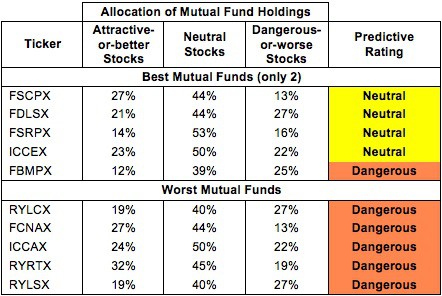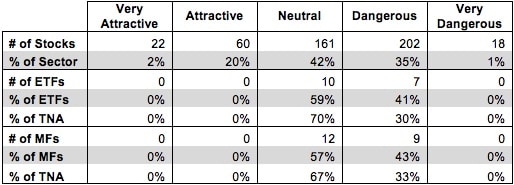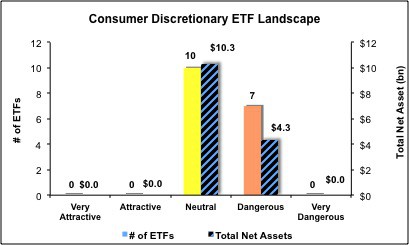The Consumer Discretionary sector ranks third out of the ten sectors as detailed in my Sector Rankings for ETFs and Mutual Funds report. It gets my Neutral rating, which is based on aggregation of ratings of 17 ETFs and 21 mutual funds in the Consumer Discretionary sector as of October 4th, 2013. Prior reports on the best & worst ETFs and mutual funds in every sector are here.
Figure 1 shows the five best and worst-rated Consumer Discretionary ETFs and Figure 2 ranks from best to worst the five Consumer Discretionary mutual funds that meet our liquidity standards. Not all Consumer Discretionary sector ETFs and mutual funds are created the same. The number of holdings varies widely (from 25 to 373), which creates drastically different investment implications and ratings. The best ETFs and mutual funds allocate more value to Attractive-or-better-rated stocks than the worst ETFs and mutual funds, which allocate too much value to Neutral-or-worse-rated stocks.
To identify the best and avoid the worst ETFs and mutual funds within the Consumer Discretionary sector, investors need a predictive rating based on (1) stocks ratings of the holdings and (2) the all-in expensesof each ETF and mutual fund. Investors need not rely on backward-looking ratings. My fund rating methodology is detailed here.
Investors should not buy any Consumer Discretionary ETFs or mutual funds because none get an Attractive-or-better rating. If you must have exposure to this sector, you should buy a basket of Attractive-or-better rated stocks and avoid paying undeserved fund fees. Active management has a long history of not paying off. Click here for a list of the Consumer Discretionary stocks that get an Attractive rating.
Get my ratings on all ETFs and mutual funds in this sector on my free mutual fund and ETF screener.
Figure 1: ETFs with the Best & Worst Ratings – Top 5
 * Best ETFs exclude ETFs with TNAs less than $100 million for inadequate liquidity.
* Best ETFs exclude ETFs with TNAs less than $100 million for inadequate liquidity.
Sources: New Constructs, LLC and company filings
Market Vectors Retail ETF (RTH), PowerShares Dynamic Retail (PMR) and PowerShares Dynamic Consumer Discretionary (PEZ) are excluded from Figure 1 because their total net assets (TNA) are below $100 million and do not meet our liquidity minimums.
Figure 2: Mutual Funds with the Best & Worst Ratings – Top 5
 * Best mutual funds exclude funds with TNAs less than $100 million for inadequate liquidity.
* Best mutual funds exclude funds with TNAs less than $100 million for inadequate liquidity.
Sources: New Constructs, LLC and company filings
Eight funds were excluded from Figure 2 because their total net assets (TNA) are below $100 million and do not meet our liquidity standards.
State Street SPDR Consumer Discretionary Select Sector (XLY) is my top-rated Consumer Discretionary ETF and Fidelity Select Portfolios: Consumer Discretionary Portfolio (FSCPX) is my top-rated Consumer Discretionary mutual fund. Both earn my Neutral rating.
iShares iShares U.S. Home Construction ETF (ITB) is my worst-rated Consumer Discretionary ETF and Rydex Series Funds: Leisure Fund (RYLSX) is my worst-rated Consumer Discretionary mutual fund. Both earn my Dangerous rating.
Figure 3 shows that 82 out of the 463 stocks (over 22% of the market value) in Consumer Discretionary ETFs and mutual funds get an Attractive-or-better rating. However, no Consumer Discretionary ETFs or mutual funds allocate enough value to Attractive-or-better rated stocks to earn an Attractive rating.
The takeaways are: mutual fund managers allocate too much capital to low-quality stocks and Consumer Discretionary ETFs hold poor quality stocks. These funds do not deserve the fees they charge when they do not allocate adequate amounts of capital to the good stocks in a sector.
Figure 3: Consumer Discretionary Sector Landscape For ETFs, Mutual Funds & Stocks
As detailed in “Cheap Funds Dupe Investors”, the fund industry offers many cheap funds but very few funds with high-quality stocks, or with what I call good portfolio management.
Investors need to tread carefully when considering Consumer Discretionary ETFs and mutual funds, as no Consumer Discretionary ETFs or mutual funds earn an Attractive-or-better rating. Seven Consumer Discretionary ETFs (30% of total net assets) and nine Consumer Discretionary mutual funds (33% of total net assets) earned a Dangerous rating. With so many Dangerous-rated funds and no Attractive ones, investors are better off by focusing on individual stocks in this sector instead of investing in ETFs or mutual funds.
American Eagle Outfitters, Inc. (AEO) is one of my favorite stocks held by Consumer Discretionary ETFs and mutual funds and earns my Very Attractive rating. American Eagle Outfitters has grown net operating profit after taxes (NOPAT) by 18%, compounded annually, over the past 15 years. Their return on invested capital (ROIC) currently stands at 15%, more than doubling their weighted average cost of capital (WACC) of 7%. At the current price of ~$14/share, American Eagle’s price to economic book value (PEBV) ratio is 0.6, which means the market expects the company’s NOPAT will permanently decline by 40%. These expectations seem awfully low for a company with such a strong history of profit growth. With strong growth, strong returns and a cheap valuation, AEO is a great stock pick in the Consumer Discretionary sector.
Stanley Black & Decker (SWK) is one of my least favorite stocks held by Consumer Discretionary ETFs and mutual funds and earns my Very Dangerous rating. Per my April 15 Danger Zone article, Stanley Black & Decker has exploited acquisition accounting loopholes to artificially boost EPS. Meanwhile, Stanley Black & Decker’s return on invested capital (ROIC) that has dropped to 7%, below its weighted average cost of capital (WACC) of 8%. The recent acquisitions are destroying value not creating it. Investors should ignore the EPS growth and focus on the fact that the company has generated in negativeeconomic earnings for the past four years. It appears, however, that investors are not paying attention to the economics of the business because the stock is significantly overvalued. To justify the current stock price of ~$91, Stanley Black & Decker must grow NOPAT 15% compounded annually over the next 10 years. These expectations are awfully high for a company with misleading earnings. Stay away from Stanley Black & Decker.
460 stocks of the 3000+ I cover are classified as Consumer Discretionary stocks, but due to style drift, Consumer Discretionary ETFs and mutual funds hold 463 stocks.
Figures 4 and 5 show the rating landscape of all Consumer Discretionary ETFs and mutual funds.
My Sector Rankings for ETFs and Mutual Funds report ranks all sectors and highlights those that offer the best investments.
Figure 4: Separating the Best ETFs From the Worst ETFs
Figure 5: Separating the Best Mutual Funds From the Worst Mutual Funds
Review my full list of ratings and rankings along with reports on all 17 ETFs and 21 mutual funds in the Consumer Discretionary sector.
Jared Melnyk contributed to this report.
Disclosure: David Trainer and Jared Melnyk receive no compensation to write about any specific stock, sector, or theme.



